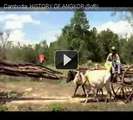Cambodia: HISTORY OF ANGKOR (4of6) [in English language]
The temples as seen today give only a sketchy idea of the total number of shrines which bejewelled the land of the Khmers, many of which must have disappeared over the centuries. They are in durable materials, and, as such, they imply considerable wealth on the part of their builders. They were far from being the only Hindu shrines in the Khmer countryside, as others were built by the less wealthy in perishable materials. The inscriptions reveal that sometimes there were years of delay before enough funds were availabe for a stone or laterite shrine for a divinity, and doubtless, some never saw the light of day because the means were lacking. The Khmers did not abandoned their indigenous deities, the masters of the land and its abundance, human heroes who became guardian spirits, and of course the protecting ancestors of each lineage. Evil spirits also roamed the land, bringing sickness or death. All these numerous and diverse divinities were worshipped, although obviously with less complex rituals than those of the Indian gods, and similarly their shrines would generally have been much simpler and built of perishable materials, as are those which house them nowadays. They were nevertheless of considerable importance in Khmer eyes and probably evoked much more dread than the Indian gods, who were naturally more remote, if only because of their ability to inflict immediate retribution when they were annoyed. These divinities were thus probably the subject of more regular attention, but not a single shrine survives, nor even a description of their rituals - unless, of course, it has gone unrecognized. While there are occasional allusions to some of these divinities in the inscriptions they are as it were accidental, since none of the texts is specifically intended for them. This is why so little is known of the foremost local deity, the 'king of the gods' who were the masters of the land, the renowned Devaraja, 'the god who is king', who was the counterpart of the Khmer 'king of kings'. Much ink has flowed on the subject of this divinity, in inverse proportion to the scanty and succinct references which exist in the actual documents.
At the end of the twelfth century some short inscriptions occur which give the names of the gods who inhabited the cellae of the temple complexes at the time. Often, these inscriptions have been erased and replaced with others, which shows the mobility of the images. Occasionally they give the name of the donor of the statue, or that of the person on whom it was modelled This type of information can also be found on the base of some of the bronze statues, and in rare cases the date of a statue's enshrining in a temple is also given.
Over the Khmer Empire as a whole. Hinduism dominated until the end of the 12th century, when it gave way to Mahayana Buddhism, although not for long. Both came from India, and although the exact means are in doubt, it is likely that Indian traders were the first to introduce their religion to Cambodia. Hinduism over the centuries had changed its focus, with different gods in ascendancy, but by the time it reached the Khmers there were two principal cults - that of Vishnu and that of Shiva. One or other would be the Supreme god, while both these two gods were also part of the Hindu Trinity (the third was Brahma) which commanded a pantheon of lesser gods and had inter alia a complex relationship. They were connected in many of the same myths, acted partly in concert, partly in rivalry.
![]()





No comments:
Post a Comment